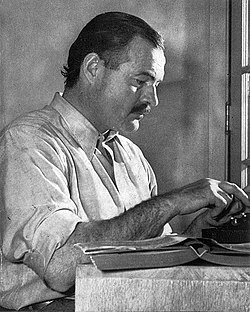Ernest Hemingway Quote
Romero never made any contortions, always it was straight and pure and natural in line. The others twisted themselves like cork-screws, their elbows raised, and leaned against the flanks of the bull after his horns had passed, to give a faked look of danger. Afterward, all that was faked turned bad and gave an unpleasant feeling. Romero’s bull-fighting gave real emotion, because he kept the absolute purity of line in his movements and always quietly and calmly let the horns pass him close each time. He did not have to emphasize their closeness. Brett saw how something that was beautiful done close to the bull was ridiculous if it were done a little way off. I told her how since the death of Joselito all the bull-fighters had been developing a technic that simulated this appearance of danger in order to give a fake emotional feeling, while the bull-fighter was really safe. Romero had the old thing, the holding of his purity of line through the maximum of exposure, while he dominated the bull by making him realize he was unattainable, while he prepared him for the killing.
Romero never made any contortions, always it was straight and pure and natural in line. The others twisted themselves like cork-screws, their elbows raised, and leaned against the flanks of the bull after his horns had passed, to give a faked look of danger. Afterward, all that was faked turned bad and gave an unpleasant feeling. Romero’s bull-fighting gave real emotion, because he kept the absolute purity of line in his movements and always quietly and calmly let the horns pass him close each time. He did not have to emphasize their closeness. Brett saw how something that was beautiful done close to the bull was ridiculous if it were done a little way off. I told her how since the death of Joselito all the bull-fighters had been developing a technic that simulated this appearance of danger in order to give a fake emotional feeling, while the bull-fighter was really safe. Romero had the old thing, the holding of his purity of line through the maximum of exposure, while he dominated the bull by making him realize he was unattainable, while he prepared him for the killing.
Related Quotes
About Ernest Hemingway
Hemingway was raised in Oak Park, Illinois, a suburb of Chicago. After high school, he spent six months as a reporter for The Kansas City Star before enlisting in the Red Cross. He served as an ambulance driver on the Italian Front in World War I and was seriously wounded by shrapnel in 1918. In 1921, Hemingway moved to Paris, where he worked as a foreign correspondent for the Toronto Star and was influenced by the modernist writers and artists of the "Lost Generation" expatriate community. His debut novel, The Sun Also Rises, was published in 1926. In 1928, Hemingway returned to the U.S., where he settled in Key West, Florida. His experiences during the war supplied material for his 1929 novel A Farewell to Arms.
In 1937, Hemingway went to Spain to cover the Spanish Civil War, which formed the basis for his 1940 novel For Whom the Bell Tolls, written in Havana, Cuba. During World War II, Hemingway was present with Allied troops as a journalist at the Normandy landings and the liberation of Paris. In 1952, his novel The Old Man and the Sea was published to considerable acclaim, and won the Pulitzer Prize for Fiction. On a 1954 trip to Africa, Hemingway was seriously injured in two successive plane crashes, leaving him in pain and ill health for much of the rest of his life. He committed suicide at his house in Ketchum, Idaho, in 1961.
